TRANSPORTATION MANAGEMENT FAQs
What is load tracking?
Load tracking is the practice of monitoring the status of loads under management. Ideally this includes automated tracking of in-transit events and current ETAs, allowing you to quickly react by rerouting loads or adjusting delivery windows to avoid potential problems. By knowing where a load is at any given time, you can reduce the number of check calls and increase your overall operational efficiency.
In this Article...
- toc
What type of load tracking software should I use?
As a freight broker, it’s important to work with a reputable, established partner that has a strong track record in the freight brokerage space and is connected with as many carriers as possible. In general, it’s best to consider a software provider that’s been in business for multiple years and provides solutions with automated status updates and multimodal visibility in real time. This will enable you to make the best use of your time while maintaining top-quality service for your customers.

What are the best features of load tracking software?
Load tracking software should provide direct connections to carrier systems via their TMS or ELD/GPS solutions for both desktop and mobile devices such as tablets or smartphones. It should be intuitive, easy to use, and include mobile features that function on both Wi-Fi and regular cell signals.
How will load tracking software benefit my business?
Automated load tracking is much easier and faster than tracking loads manually. It can save your staff enormous amounts of time and free them up to focus on other tasks. With load tracking software, you can also maximize capacity and avoid deadheading thanks to better planning and tighter booking. This can boost customer satisfaction and retention while helping you reduce penalties such as chargebacks and detention from customers and carriers.
Learn more about Load Tracking



